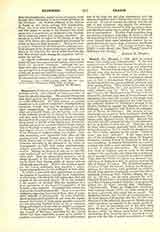

Exarch (Gr. Eksarchos), a title used in various senses both civilly and ecclesiastically. In the civil administration of the Roman Empire the exarch was the governor or viceroy of any large and important province. The best-known case is that of the Exarch of Italy, who, after the defeat of the Goths, ruled from Ravenna (552-751) in the name of the emperor at Constantinople. In ecclesiastical language an exarch was, at first, a metropolitan whose jurisdiction extended beyond his own (metropolitical) province, over other metropolitans. Thus, as late as the time of the Council of Chalcedon (451), the patriarchs are still called exarchs (can. ix). When the name “patriarch” became the official one for the Bishops of Rome, Alexandria, Antioch (and later of Constantinople and Jerusalem), the other title was left as the proper style of the metropolitans who ruled over the three remaining (political) dioceses of Diocletian‘s division of the Eastern Prefecture, namely the Exarchs of Asia (at Ephesus), of Cappadocia and Pontus (at Caesarea), and of Thrace (at Heraclea). The advance of Constantinople put an end to these exarchates, which fell back to the state of ordinary metropolitan sees (Fortescue, Orth. Eastern Church, 21-25). But the title of exarch was still occasionally used for any metropolitan (so at Sardica in 343, can. vi). Since the use of all these titles became gradually fixed with definite technical meanings, that of exarch has disappeared in the West, being replaced by the names “Apostolic vicar” and then “primate”. A few cases, such as that of the Archbishop of Lyons, whom the Emperor Frederick I named Exarch of Burgundy in 1157, are rare exceptions. In Eastern Christendom an exarch is a bishop who holds a place between that of patriarch and that of ordinary metropolitan. The principle is that, since no addition may be made to the sacred number of five patriarchs, any bishop who is independent of any one of these five should be called an exarch. Thus, since the Church of Cyprus was declared autocephalous (at Ephesus in 431), its primate receives the title of Exarch of Cyprus. The short-lived medieval Churches of Ipek (for Servia), Achrida (for Bulgaria), Tirnova (for Rumania), were governed by exarchs, though these prelates occasionally usurped the title of patriarch (Fortescue, Orth. Eastern Church, 305 sq., 317 sq., 328 sq.). On the same principle the Archbishop of Mount Sinai is an exarch, though in this case, as in that of Cyprus, modern Orthodox usage generally prefers the (to them) unusual title, “archbishop” (Archiepiskopos). When the Bulgarians constituted their national Church (1870), not quite daring to call its head a patriarch, they made him an exarch. The Bulgarian exarch, who resides at Constantinople, is the most famous of all persons who bear the title now. Because of it his adherents throughout Macedonia are called exarchists (as opposed to the Greek patriarchists). It was an inaccurate use of this title when Peter the Great, after abolishing the Patriarchate of Moscow (1702), for twenty years before he founded the Russian Holy Directing Synod, appointed a vicegerent with the title of exarch as president of a temporary governing commission. Since Russia destroyed the old independent Georgian Church (1802) the Primate of Georgia (always a Russian) sits in the Holy Synod at St. Petersburg with the title of Exarch of Georgia (Fortescue, Orth. Eastern Church, 304-305). Lastly, the third officer of the court of the Patriarch of Constantinople, who examines marriage cases (our defensor matrimonii), is called the exarch (ibid., 349).
ADRIAN FORTESCUE

